Traditional Thai house
Traditional Thai house
Thai houses in Thailand are difference in styles depend on native people that lives in each parts of the country, and it climate. Traditional Thai houses are well adapted to the lifestyle needs and climatic conditions. Simplicity and open space are the core features of the Thai style house. Whole families would sleep together in a single room. In some instances, the open space was partitioned off into separate living areas to accommodate various generations. In a typical old Thai house, the various rooms would be separate units connected by open walkways and the staircase was on the outside.
Mainly , we divided them into 4 part :- central , Northern , North-eastern and Southern which all difference styles and details.
Central style
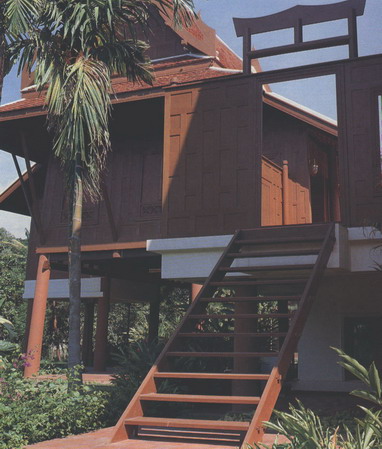
Central style
The main and most outstandind style is Thai central plain style, that have survived to our time. The majority of them were built between some 100 to 150 years ago. They are known for high gabled roof, wood panel, generously wide eaves, ample space underneath the house on stilts. Thai houses in the central plain come in different categories, i.e. Thai house for lone family unit, Thai house that does business on the dry land, residence for royal personages, and living quarters for Buddhist monks. Characteristics of Thai Houses in the Central Plain :
1. High floor level allowing an averaged man to walk with clearance above his head. High floor level are builded for the following reasons:
1.1 As a measure against any inconvenience from flooding.
1.2 Space under the house for storage of farming equipment such as wagon, planks, boats, ploughing set, large frying pan, etc.
1.3 Floor space under the house is used for producing handicraft, and a common sitting or squatting area.
1.4 Safety from wild beasts and possible intruders during night time.
2. High gabled roof and ample slanting eaves, and the roof cover made from a tap or earthenware tiles.
3. Large platform area which may represent as much as forty percents of the total floor area allowing exposure to sunlight and good clean air.
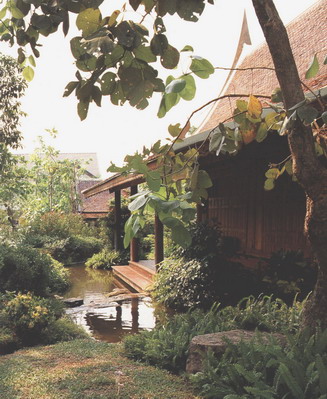
There is a functional aspect behind this design and structural element. Hot air rises so the height of the roof keeps the house cool. Thai house in the central plain has its roof line oriented along east west direction. This is to cut down the amount of sun light into the main body of the house and at the same time obtain the maximum benefit of the cool winds. Walls were generally left unpainted, though sometimes oiled. The curved roof-ends which give the tip of the eaves a highly distinctive look and add to the graceful appearance of the Thai houses are symbolic of the 'nagas' or serpents that adorn the Khmer temples. They have been stylized and often bear little resemblance to the original art form.
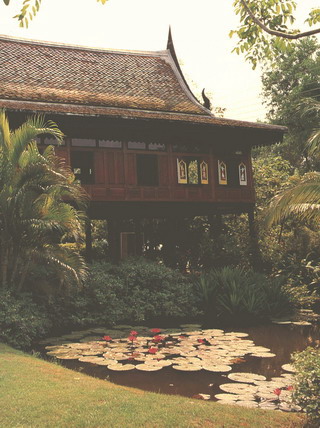
CONSTRUCTED WITHOUT NAILS
Traditional Thai house in the central plain are only style that built with pre-febricated system , allowing people to built or move easily,and groups together with many form of functions. One practical feature of the Thai house is the ease with which it can be assembled or taken down. The entire house is built in light, pre-fabricated sections with each section forming a wall. Each wall is then fitted together and hung on the superstructure - a frame of wooden pillars - without nails. In former times, the fact that the house could be taken down and re-assembled with relative ease was well-suited to the indigenous way of life. When families decided to move, as they frequently did, the house would be taken down, stacked on a raft and floated down the nearest klong to a new
Northern style (Lanna)
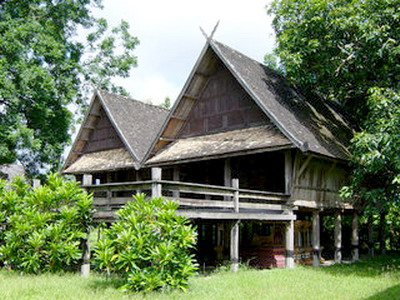
Northern style (Lanna)
The Lanna or the northern people favor the valleys that are the river basins for settlement. The northern region which begins from Sukhothai all the way to Chiangmai and Chiangrai is dominated by mountains and rain forest. The year round climate is the coolest of all regions. The typical house in the north is rather well walled in with less space for windows, and small ample space for platform. A shelf for a row of earthenware water jars is to be found on one side of the house, or infront for traveler. The walls tend to be slanted toward the eaves the main body of the house is usually surrounded by large open space.
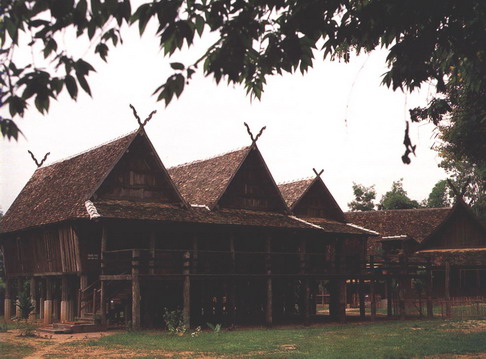
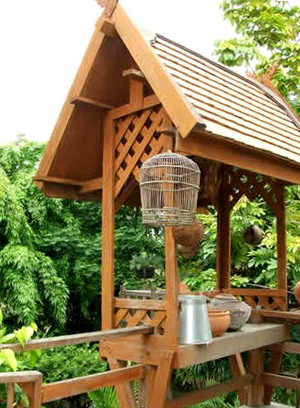
Lanna house as a rule faces east with the roof ridge oriented along north south direction. The house is thus exposed to ample sunlight and at the same time protected from northern winds in the cool season. The house of the north falls into three main categories i.e. tied house (reuan kruang pook), hard wood house (reuan kruang sab or reuan katae) and the house in a mixed style between the traditional and the western ideas.
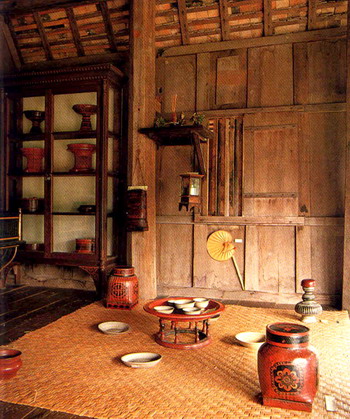
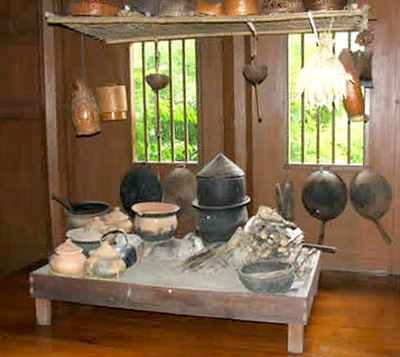
Tied house represents the true tradition of the house of the northern people. Supporting posts and beams are in hard wood while the walls are made from juxtaposed bamboo slats. The roof cover itself is made from large leaves or reeds. Reuan kruang sab or reuan kalae to which similar to reuan krunag sab is built from hard wood introduced during the reign of King Rama V, the house in the mixed style between local and western (Victorian & ginger bread style) is richly decorated with carved and cut wooden fleeces also known as the "sala nai" style.
North-eastern style
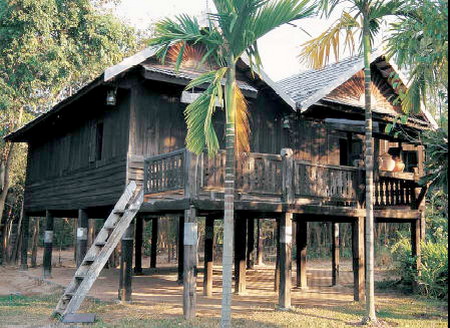
North-eastern style
Thai House of the northeast are built with due considerations for dryness, hot temperatures in the hot season and cool temperatures in the cool season. The geo-economic conditions and believes also play their parts in the evolve of the house styles of the northeast.
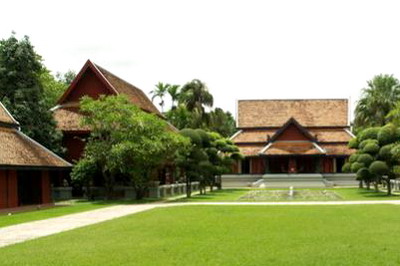
Early northeastern villages are relatively small and widely scattered over the entire region. The passage of time sees rice farmer families numbering from 100 to 400 gradually gather to from bigger villages. The typical village is crisscrossed by walkways along the length and width of the village dividing it into groups or "koom". Each koom is given a name for the purpose of record and registration. There are to be found in a village, a school a rice mill and a village court of law and a reservoir.
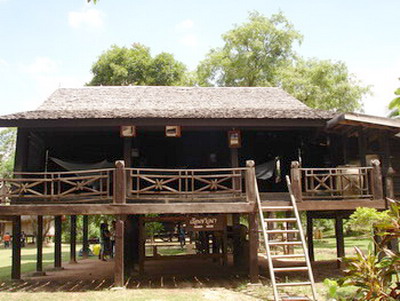
The layout of the houses in each koom gives no hint of symmetry or systematic planning. The orientation of the roof of each house is invariably along the east west direction. The space between one house and the next is not fixed, but on the average about four meters. Most if not all houses are without fences. Each house is accompanied by a granary built close to the house either to the north or south of the house.
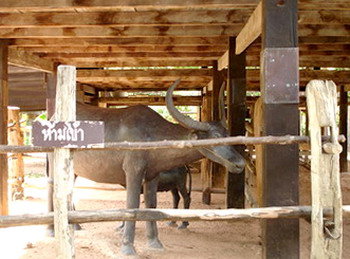
The average house is designed for a single family. The house plan is simple consisting of a bed room, corridor, a kitchen, and a shelf for shoring water. Some houses may have "ruan kong" added to the main house. Ruan Kong is a hall room built opposite to the bedroom. Most houses have no partitions and assigned areas are not clearly marked off one another. Houses of the northeast rice farmers maybe classified into four main styles :
1.Gable roofed house in the traditional style.
2.House with ruan Kong. (walls on three side)
3.House without ruan Kong
4.Temporary house
Southern style
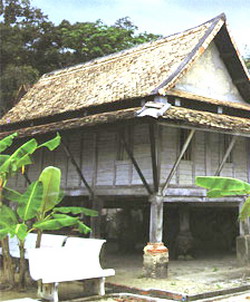
Southern style
Thai houses in the south are quite similar to those found in other regions of the country. There are ruan kruang pook (tied house), ruan kruang sab (wooden house) both of which have undergone development which gives the southern people the cement brick house. Their peculiarities are supporting posts resting on stone slabs to prevent termites attack, and dampness from the ground seeping through. The space under the house is rather generous while the roof is set rather low. This design makes the house better withstand strong winds and rains. The slant of the extended roof allows rain water to run off the roof quickly and help the roof to get dry quickly also. The alignment of the supporting posts and the walls are slanted inwards. The style known as "Elephant in a urinating posture" is thought to make the house absorb the impacts of strong winds more effectively, permits easy ventilation and at the same time protect the ground under the house from collecting an excessive amount of rain water. The walls are made of wooden boards arranged in such a way that the upper board overlaps the lower one to prevent rainwater running through the wall on the inside of the house.
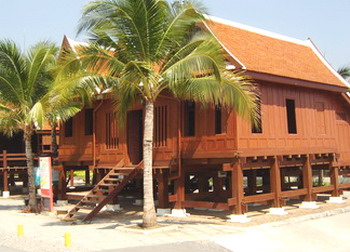
Thai house of the southern region has its longer side oriented in the east to west direction known in the dialect as "pluk baan loi wan" meaning setting the along the south to north direction. Doing so would expose the house to full sun light almost half a day and also to strong winds which are liable to blow from east to west directions. The alignment of the granary is the opposite of that of the house. By setting the longer side of the granary along the north south direction, the paddy in the granary will get all sun light it needs to get dry. The granary of cause is more sturdily built than a regular house.
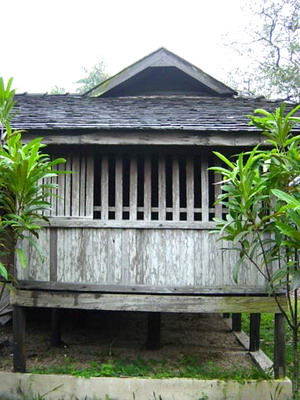
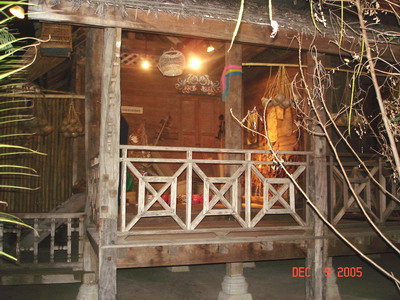
Thai house in the south is built as a single unit for one family's living. When the family grows large, another house is built along the main house together with a platform linking the two houses into a single unit. The platform area of Thai house in the south is small and narrow compared with the same of Thai houses in other regions. This is probably due to frequent rains in the south and narrow or small platform helps one to move from one house to other in as short a time as possible and hence get least wet. In some areas of the south, brick work or even an earth mound is built to the level of the platform and use for growing flowers or small plants such as promagrenade, orange lime, vegetable or perfume wood plants. The roofs of Thai house in the south come in four major styles i.e. gabled, "panyah"(hip roof) "kabranoh" and manila.
"TraveLArounD"
Edited from : National Culture Commission and
//www.jimthompsonhouse.com/museum/fascinat.asp
| Create Date : 01 กรกฎาคม 2551 |
| Last Update : 2 กรกฎาคม 2551 12:10:29 น. |
|
4 comments
|
| Counter : 7057 Pageviews. |
 |
|
|

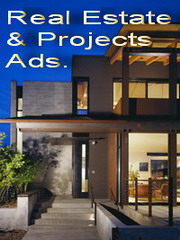
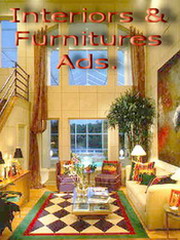
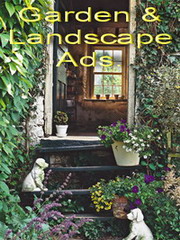
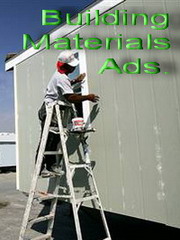

เคยไปชมพิพิธภัณฑ์บ้านไทยเหนือที่เรือนคำเที่ยง
มีเรือนครัวเหมือนในตัวอย่างข้างบนเลยค่ะ
ได้ความรู้เรื่องบ้านภูมิปัญญาไทยทั้ง 4 ภาคเลย
เป็นประโยชน์สำหรับผู้ที่กำลังศึกษาเรื่องนี้ หรือ
ผู้ที่สนใจทั่วไป .. ขอบคุณมากๆ นะคะ